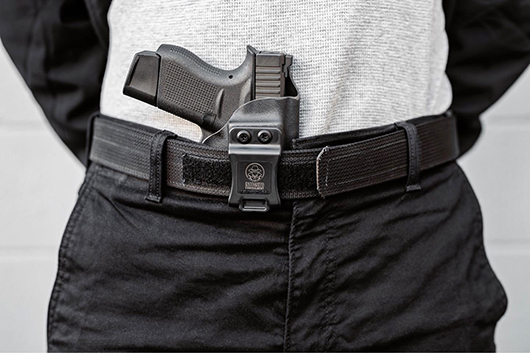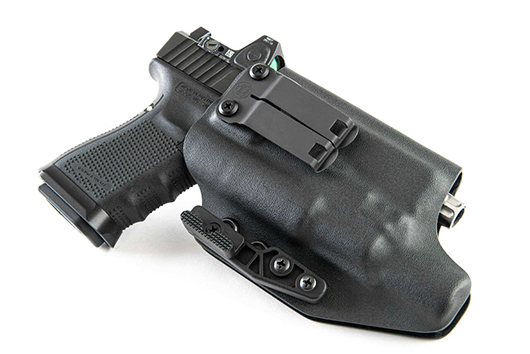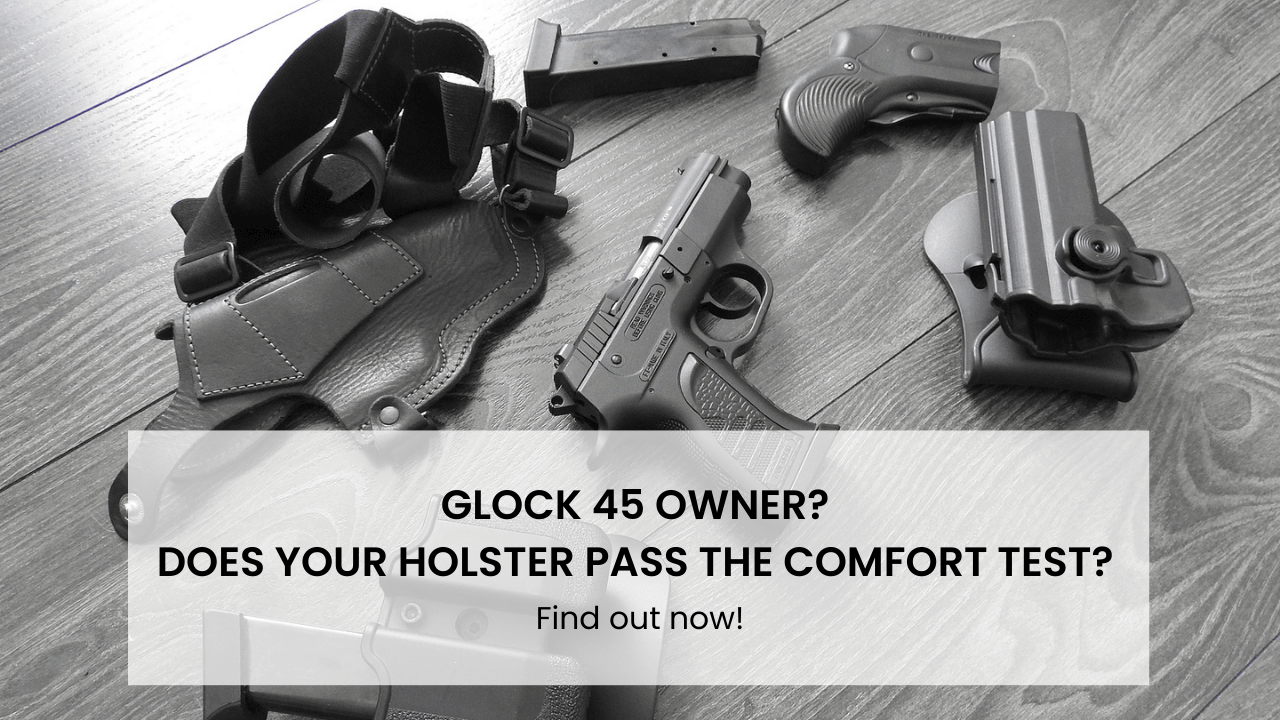How to Choose the Best SIG Sauer P938 IWB Holster
Jul 9th 2021

Introduced in 2011, the SIG P938 is a 9mm semi-automatic pistol designed for concealed carry. In a sea of striker-fired, polymer-framed handguns, the P938 is designed to meet the demand for a more traditional hammer-fired pistol with a metal frame. This appeals to both modern shooters and traditionalists, and SIG has a reputation for manufacturing some of the most rugged and reliable handguns on the market.
When you’re searching for the ideal handgun for concealed carry, there’s more to carrying a firearm than the gun. You need a holster in which to carry your weapon safely, securely, and in a way that affords reliable access.
SIG Sauer P938
The P938 is the 9mm variant of the P238, a handgun design inspired by John Browning’s 1911. The P238, chambered in .380 ACP, is a single-action-only semi-automatic pistol designed for concealed carry. As a result, to ready the weapon for firing, you have to cock the hammer, either manually with your thumb or by retracting the slide, for the first shot.
The SIG Sauer P938 fires the more powerful 9mm Luger cartridge, providing additional muzzle energy and penetration. But, don’t think this compromises its concealability or convenience; the weight and dimensional changes are minor.
The pistol mates a stainless-steel slide to an anodized aluminum-alloy frame, which keeps the weight to a modest 16 ounces. With a 3" barrel, the P938 has an overall length of 5.9" and a sight radius of 4". As the P938 is fed from a single-stack magazine, the width is only 1.1", which is comparable with the Glock 43.
However, the height of the weapon is one of the most critical dimensions to minimize in a concealed-carry handgun. At ¼” shorter than the Glock 43, the 3.9" height of the P938 reduces the risk of printing considerably. The result is a highly compact firearm that lives up to its Micro-Compact size designation.
The short frame of the P938 reduces the length of the front strap and, thus, the gripping surface. That’s one of the primary disadvantages of concealed-carry handguns. SIG Sauer offers an extended magazine to compensate for this reduction in height for those who would prefer additional weapon control. The extended magazine also increases the magazine capacity by one round to seven.
Carry Positions

There are different concealed-carry positions to choose from. In waistband carry, where you place the weapon on your gun belt, is represented by hour-hand positions on a clock face. The most common positions are:
Strong side
Also called hip carry, your strong side is your dominant side. In a strong-side holster, you wear your gun on or behind your right or left hip. Popular, strong-side carry is comfortable under most circumstances and allows you to maintain distance between your weapon and the threat. It can, however, be challenging to draw from this position when seated in a vehicle, especially if your shirt is also tucked in.
Appendix
Appendix carry places the weapon behind or beside your belt buckle — the center of your torso. Concealable and comfortable for those with a relatively flat abdomen, appendix carry is also potentially very fast. However, this position can be controversial due to the direction in which the muzzle is pointed. If you didn’t already have enough incentives to practice trigger discipline, reholster carefully, and choose a rigid holster design, the prospect of bleeding to death adds another.
Cross draw
A cross-draw carry position places the handgun on the support side with the butt forward. Cross draw isn’t as popular as it used to be, but for those who spend prolonged periods seated, such as truckers, this method does provide easy access inside a vehicle or behind a desk.
Small of the back
Small of the back carry, places the weapon at the 6-o’clock position, above your tailbone. While this position can be highly concealable, it also limits accessibility if you have your back facing a wall and can cause injury if you fall.
Non-Waistband Holsters
Non-waistband positions are also popular for different types of weapons, depending on the application and other factors. They do, however, have their drawbacks.
Shoulder and Ankle Holsters
The shoulder holster requires that you wear a cover garment, such as a jacket. This may not be an unreasonable requirement during the colder months, but in the sweltering heat of July or August, this is not always viable.
One-handed reholstering is also more difficult. Many shooting schools forbid shoulder holsters for range practice because many designs cant the muzzle horizontally, causing it to cover anyone standing behind you.
The ankle holster, typically worn on the inside of the non-dominant leg, can be useful for carrying highly compact, pocket-sized handguns as a backup; however, for a primary weapon, it is neither sufficiently comfortable nor accessible to be practical.
Off-Body Carry
Unless you have no choice, you should try to avoid carrying a handgun in an off-body location, such as in a backpack or purse. These methods of carry limit access to your weapon and, regarding purses, are also more likely to be stolen.
Conditions of Readiness
There are several conditions of readiness when carrying a hammer-fired handgun for self-defense. A single-action-only semi-automatic pistol typically has a manual safety lever accessible via the dominant thumb, and the P938 is no exception. The preferred method of carrying an SAO handgun is Condition One: “cocked and locked.”
With a round in the chamber and the hammer cocked, engage the manual safety by raising it until it clicks. The P938 has an ambidextrous safety, so whether you’re a right- or left-handed shooter, you’ll be able to manipulate the controls with ease.
When you’re ready to fire, you’ll lower the safety with your thumb. Unlike the traditional 1911 pattern, there is no grip safety.
Holster Elements to Consider
SIG Micro-Compact handguns, regardless of caliber, are designed for deep concealment. The best type of holster for concealable pistols is the IWB (inside the waistband). IWB holsters allow you to take full advantage of a pocket-sized handgun, hiding it between your pants and your body. The ideal IWB holster should meet certain requirements to be functional, safe and promote ease of draw when you need your weapon most.
Concealability
An IWB holster is designed for concealment; therefore, it should minimize your weapon printing to the greatest extent possible. Printing refers to a condition in which the outline of a concealed firearm becomes visible through clothing. Your choice of gun belt and wardrobe also determine, to an extent, how concealable your weapon remains.
Concealment Devices
You can increase the concealability of your holster by using concealment devices, such as wings and wedges. A holster wing, for example, applies pressure against the inside of your waistband, which drives the holster into your body and away from your belt.
Belt Clips
The purpose of a belt clip is to attach the holster at one or more points to your gun belt to secure the holster and distribute the load uniformly. Belt clips come in a variety of designs, each attaching differently.
For deep concealment in an IWB holster, you may also consider selecting a tuckable holster. This means that you can tuck the fabric of a T-shirt or collared shirt into a space between the belt clip and the holster.
The belt clip remains exposed, but the holster is hidden under clothing. Tuckable holsters are compatible with all major waistband positions and can significantly increase the concealability of your weapon. You need to practice your draw stroke while carrying in this manner, as the dynamics are somewhat different.
Gun Belt
Multiple factors can affect the visibility of your firearm. A gun belt is a specialized firearm accessory, providing the strength and rigidity necessary to keep the gun and holster in the same position consistently. Dress belts are inadequate for this purpose because they’re not designed to support an asymmetrical load for prolonged periods. A gun belt shouldn’t sag or cause your holster to cant outward from your body — that can cause printing. It should be able to withstand the constant use of belt clips and other concealment devices.
Holster Retention
If you’re carrying a weapon for self-defense, you need it to be secure by your side at all times. If it’s not held securely in place, it’s a liability, not a vital tool for personal protection. That’s why retention is critical — it ensures your safety and the safety of others. You should not have to restrict your range of motion in your daily life for fear of losing your weapon.
Aside from preventing your weapon from falling out, retention, as a property, renders disarmament more difficult. However, this benefit is more applicable to open-carry and OWB holsters that employ an active-retention system. As IWB holsters are designed for concealed carry, no one should know that you’re armed if you’re carrying your weapon properly.
Discreet carry allows you to wear a passive-retention holster. Using a custom-molded thermoplastic, such as Kydex, a passive-retention holster does not delay or complicate your draw stroke. Acquire a full firing grip on the weapon and apply upward force to break it free — that’s it: no levers, buttons, or other locking mechanisms to manipulate.
Kydex Holster Construction
Kydex holsters consist of two sheets of material cut to the correct size. The manufacturer heats the Kydex sheets to render them pliable and sandwiches a specific firearm between them. Under applied pressure, the Kydex sheets cool and conform to the exterior dimensions of the weapon, forming a glove-like fit.
One feature that your holster should have is adjustable retention. In a passive-retention holster that depends on the close-tolerance fit between the exterior of the gun and the interior surface of the holster shell, it’s important to increase or decrease the tightness to suit you. By tightening or loosening one or two screws, the two Kydex sheets are drawn closer together or spaced farther apart.
Easy Access
In addition to retaining your weapon, your holster should provide immediate access to your weapon and need it most. Two factors that affect accessibility are cant and ride height, both of which should be adjustable.
Cant
Cant is the angle of rotation relative to the centerline of your waistband. When your gun’s muzzle is perpendicular to the ground, its cant is neutral. When the gun has a positive or forward cant, the grip rises. You’ll need to adjust the cant for two primary reasons: maximizing access and minimizing printing.
A standard forward cant for a strong-side position is between 15 and 22.5°. In appendix-carry positions, a neutral cant of 0° is the default.
Ride height
Ride height is the height at which your gun rides relative to the centerline of your waistband. Ride height is typically expressed at high, mid, or low. When high, the beltline is below (or in front of) the trigger. When carrying at mid-ride height, the belt is about level with the trigger. At a low ride height, the belt is above (or behind) the trigger.
Each ride height will affect concealment and accessibility. A higher ride height will be more comfortable for some and expose more of the grip; however, it will also reduce concealability. A lower ride height will have the opposite effect.
You’ll need to balance these interests and choose the ride height and cant that best complement each other. There should always be sufficient clearance between the front strap of the frame and the belt to allow for a full firing grip.
Sweat Guard
In a Kydex holster, the holster has a sweat guard or shield when the rear sheet extends upward, partially or fully covering the slide. The sweat guard acts as a barrier, preventing contact between the firearm and your body.
Some shooters may find that a sweat guard interferes with the draw stroke, so you’ll need to experiment with your intended holster to ensure that it doesn’t impede your ability to gain a solid purchase on the firearm.
Holster Safety
Firearms safety is your responsibility as a gun owner. The priority is to understand and consistently apply the four basic rules of firearms safety:
- All guns are always loaded. Even if they are not, treat them as if they are.
- Never let the muzzle cover anything you are not prepared to destroy.
- Keep your finger off the trigger until your sights are on the target.
- Be aware of your target and what is behind it.
Following Rule 3 is referred to as trigger discipline. To avoid involuntarily pressing the trigger under stress, due to nervous action, or because of an accident, you keep your finger straight alongside the trigger guard, frame, or slide of the handgun. This, alone, significantly reduces the incidence of negligent discharges.
A holster should always have a fully covered trigger guard so that it’s not possible for your index finger to enter the trigger guard or contact the trigger until you have drawn the weapon and it has fully cleared the holster. Furthermore, if the holster uses an active locking mechanism, it should require that you deactivate it with your thumb, not your index finger.
Durability
There are various holster materials to choose from, but the two that remain the most popular are leather (tanned animal hide) and Kydex (molded thermoplastic).
Your carry holster should be durable. It should resist abrasion and impact to protect your firearm from damage. In addition, the holster should allow for one-handed reholstering. To achieve that, the holster must remain rigid. Kydex does not deform, retaining its shape under adverse conditions. Collapsible holsters often prevent you from returning your weapon unless you use two hands, which can compromise safety.
Kydex also has another important advantage relative to leather: it’s inherently waterproof. Kydex won’t absorb water, swell, or warp. You can also clean and dry Kydex holsters and sheaths easily, which is why they’re preferred for outdoor use.
You should note, however, that Kydex has less give or cushion to it. As it’s less compressible, it won’t absorb impact as well as leather, instead transferring it to you. Its hardness and tight grip on the weapon can also abrade the finish over time.
Increase Your Ammunition Capacity
The P938, as a Micro-Compact handgun, has an inherently limited magazine capacity. Its standard magazine holds six 9mm cartridges in a single feeding column, the same as the Glock 43. SIG Sauer also offers a 7-round magazine with an extended and curved base plate for added grip.
If you want extra ammunition, you can carry one or two spare magazines in pouches or carriers on your support side. The pouches you select should meet the same performance standards as your holster.
The Bottom Line
Regardless of the handgun you choose to carry, don’t neglect the importance of a high-quality concealed-carry holster. At Incognito Concealment, we manufacture Kydex holsters for every popular handgun brand, ensuring a perfect fit every time, and all our holsters are made in the United States.
We understand the importance of having a holster that allows you to carry your firearm safely and securely without compromising access. When you need to draw your weapon, you need it immediately. Check our products to see which holster design suits your carry style best. If you need help choosing the right holster, don’t hesitate to give us a call.
FAQs
Is the SIG P938 a good carry gun?
The SIG P938 is a highly concealable firearm that has also demonstrated itself to be reliable. If you’re interested in a 9mm handgun for your CCW but want a 1911-inspired design, the P938 is an excellent choice.
Is the SIG P938 safe to carry?
Yes. You can rest assured that the P938 is safe to carry, especially with the manual safety engaged.
In a standard 1911-pattern handgun, retracting the slide to check the chamber is not possible when the safety is engaged; therefore, to perform a chamber check or unload the weapon, you need to take the safety off. The P938, however, does not lock the slide when the safety is engaged, so you can check the chamber and unload the weapon with the safety on.











